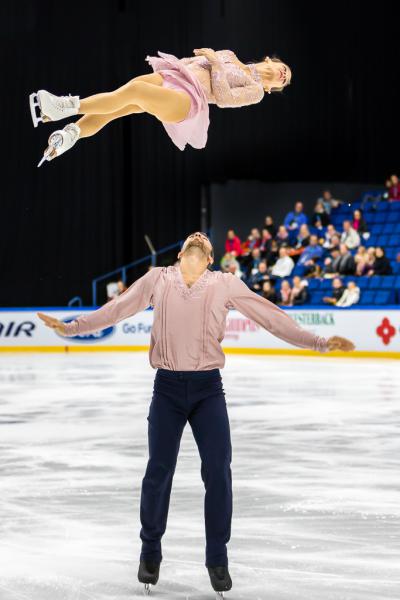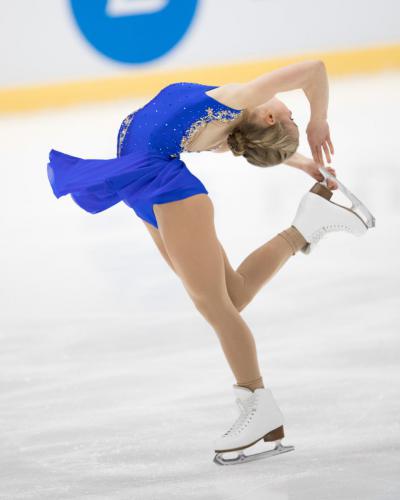While in Single Skating male and female skaters compete individually, in Pairs and Ice Dance there is always a couple. Here are some hints on hou you can recognise these two disciplines from each other.
As in Singles Skating, Pairs also execute solo jumps and spins ( that are done side by side). However the most recognizable elements in Pair Skating are lifts, death spirals, twist lifts, pair spins and throw jumps.
The key to Pair Skating is exact timing and unison. Whether the partners are skating together or apart, their movements should be synchronized with matching body lines, gestures and footwork.

Unlike Pair Skating, which features overhead lifts and jumps, Ice Dance is based on the different aspects of dance. The emphasis in Ice Dance is on rhythm, interpretation of the music and precise steps. Its beauty lies in its limitless creativity, choreography, and its theatrical and innovative aspects. Lifts with different lengths and types, step sequences, dance spins and twizzles are the key movements in Ice Dance.
Both singles skaters and couples execute a Short Program and a Free Skate. 24 Ladies, 24 Men, 16 Pairs, and 20 Ice Dance couples qualify for the Free Skating after the Short Program. In Ice Dance the programmes are called Short Dance and Free Dance.
The Short Program, which can be no longer than 2 min and 50 seconds, is skated first and should contain a certain amount of prescribed elements.
The Free Skating is 4 minutes (+/- 10 seconds) for Ladies and Ice Dancers and 4 minutes and 30 seconds (+/- 10 seconds) for Men and Pairs.
Skaters also choose music for their programs around which choreography that includes the various elements is built. Music has traditionally been restricted to instrumental music, but since the 2014-2015 season vocal music has also been allowed.
Figure skaters in the four disciplines (men, ladies, pairs, and ice dance) are entered into the championships by country. Based on the ISU technical scores each country’s skating association may enter one skater or a couple in each event. However, some countries are permitted to enter two or three participants if their skaters performed well enough at the previous year’s world championships.
The technical elements consist of Jumps, Spins and Steps. The Technical Score is decided by the difficulty and quality of the step sequences, jumps and spins. The difficulty in step sequences and spins is measured by level: Base, 1, 2, 3, and 4, where 4 is the highest. The Technical Panel determines the level. Each jump receives a score according to its base value as well as a grade of execution (GOE). The quality is decided by nine judges, and it is measured on a scale from -3 (completely missed), to +3 (super).
The Program Components consist of Skating Skills, Transitions, Performance/Execution, Choreography and Interpretation.
The Program Component Score is decided by the judges. The scale is from up to 10. The Program Component Score and the Technical Score are added together and this is how we get the Total Segment Score. To get the Final Score the Total Segment Scores from the Short Program and the Free Skating are added together. The Bigger the score, the better the result.

Accidentally landing a single jump or a double jump instead of a planned triple jump is often more costly than falling down. The skater will receive a 1 point deducation for each fall.
Underrotating a jump is also a small mistake. If there is more than a quarter but less than half of a turn left in the landing, the jump will lose about 30 per cent of its value. If there is more than half of a turn or more left, the jump is downgraded. This means that when a skater executes for example a triple jump but is missing half of a turn, the jump will be downgraded to a double jump. It can be difficult to see it but the technical panel can also review the landings in slow motion. This is why the skater sometimes has to wait for their points for a quite a long time.
There are limits as to which and how many jumps, spins, step sequences and/or lifts the Men, Ladies and Pairs can do. If the skater/couple repeats a jump too many times, they will collect in zero points for the last repetition. Even if the skater makes obvious mistakes in the jumps, a lot of points can be collected for the spins.
A skater may also receive deductions such as Music Violations, Costume/Prop Violations, Time Violations, Interruption in Excess or Extended lift.
Jumps are classified as either edge jumps or toe jumps. An edge jump takes off directly from the edge without assist from the other foot, while in a toe jump the skater spikes the toe picks of the free foot into the ice and at the same time jumps off.
It is launched from the forward outside edge and landed on the back outside edge of the opposite foot. It has a forward take off but lands backwards. The Axel has an extra half rotation.
SALCHOW
It takes off from a back inside edge and lands on the back outside edge of the opposite foot.
LOOP
The Loop jump is a jump that takes off from a back outside edge and lands on the same backwards outside edge.
The Toe Loop takes off from the toe pick, while the other foot travels on the back outside edge.
FLIP
In a Flip, the skater "digs" the toe picks (different toe pick from Toe Loop) into the ice while the other foot skates on the back inside edge.
LUTZ
In a Lutz, the skater also digs his/her toe pick into the ice just like in a Flip, but here the other foot skates on the back outside edge.
© 2005-2016 Finnish Figure Skating Association